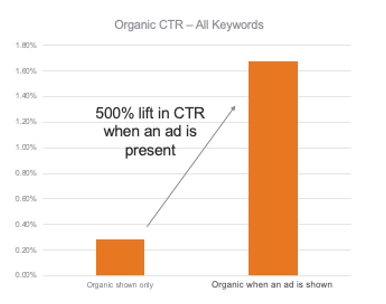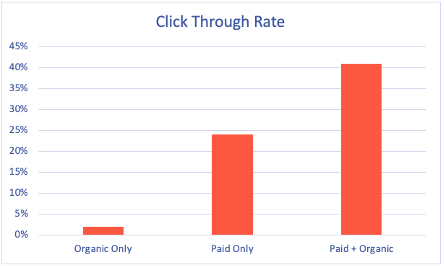Why invest in branded search?
When it comes to search, there’s one question almost every marketer asks: should I bid on my branded search terms.
We’ve conducted brand search analyses many times, for many brands in a wide variety of verticals, but the answer is always the same: branded paid search is important because organic listings simply cannot pick up the same amount of traffic on their own. Paid search provides an additional place on the search engine results page for users to click, which increases the likelihood that a user clicks through to the brand’s website. Brand search ads increase the authority of said brand and keep competitors’ ads at bay. And time again, we’ve found that when paid and organic listings show together, there are incremental clicks on both the ad and the organic listing. In short, the whole is greater than the sum of its parts.
Let’s break this all down.
What’s the intent behind a brand search?
By definition, a “brand search” is any keyword that includes the name of a brand or branded product (think Dyson vacuum). In contrast, a “nonbrand search” is any keyword that does not (best vacuum for wood floor). Generally speaking, users searching on brand terms are the most informed consumers and therefore most likely to purchase your product. There are certainly exceptions to this, but that’s why we almost always see the bulk of conversions come from branded search.
An obvious next question often arises: then why advertise on brand search? If a user is searching your brand and the most qualified to convert, what is the need to pay for that click?
Why you should invest in brand search
Across clients, Collective Measures has found time and time again that paid search has a halo effect on the organic click-through rate. So, while having an ad requires you to pay for your clicks, it also increases the likelihood that a user clicks your organic listing for free.
A very common analysis shared across the web is the incremental clicks that come from having both a paid and organic listing present simultaneously. As demonstrated in the graphic below, this analysis illustrates the click-through rate (CTR) when only an organic listing is present, the click-through rate when only a paid ad is present, and the click-through rate when both show together. The original source is already years old, but the results stand the test of time and have proven true every time we’ve conducted the analysis: when both paid and organic results are present, more clicks are driven to a brand’s website than either source could drive on its own.

The Halo Effect
 Often overlooked is the halo effect that paid search has on organic and vice versa. For newly established brands, CM has found without brand recognition, appearing multiple times in the search engine results page (SERP) can help to establish credibility and increases the likelihood that a user will click through to the brand’s website. Depending on the industry, the number of competitors in the auction, and other listings on the SERP, CM has seen that CTR increases when an organic listing is present, and vice versa.
Often overlooked is the halo effect that paid search has on organic and vice versa. For newly established brands, CM has found without brand recognition, appearing multiple times in the search engine results page (SERP) can help to establish credibility and increases the likelihood that a user will click through to the brand’s website. Depending on the industry, the number of competitors in the auction, and other listings on the SERP, CM has seen that CTR increases when an organic listing is present, and vice versa.
One specific example: For a challenger healthcare brand with many competitors in the paid search auction, there is a substantial increase to organic click through on branded keywords when an ad is present. In this instance, without an ad present, the organic listing wouldn’t be able to generate the amount of clicks it’s able to generate when an ad shows above it. The incremental clicks resulted in over 200 leads in a month that wouldn’t have occurred without the paid presence, even though in Google Analytics these leads are attributed to organic.
At CM, we’ve also seen the inverse to be true. For brands with a stronger brand presence and not as many competitors, the presence of an ad often decreases the number of clicks coming through organically. However, the presence of the organic listing increases the paid CTR by a larger margin, which results in incremental clicks overall that organic could not generate on its own.
 Another example, this time for a life sciences brand. While there was a 23% decrease in organic CTR when a paid ad was present, there was a 30% increase in paid CTR because it was showing alongside the organic listing. While organic search results would certainly pick up a portion of the traffic if paid ads were not present, there would still be a revenue loss of ~$400,000 per month. To understand the true incrementality for this brand, CM looked at the combined click-through rate to see the overall gains of having both listings present.
Another example, this time for a life sciences brand. While there was a 23% decrease in organic CTR when a paid ad was present, there was a 30% increase in paid CTR because it was showing alongside the organic listing. While organic search results would certainly pick up a portion of the traffic if paid ads were not present, there would still be a revenue loss of ~$400,000 per month. To understand the true incrementality for this brand, CM looked at the combined click-through rate to see the overall gains of having both listings present.
Are there times when brand search might not drive revenue?
This is a common question, especially for brands in the CPG industry. Stated broadly: your branded terms should certainly be driving revenue. But there may be instances where your brand terms may not be driving as much revenue as other campaigns. For example, if your brand has products sold through multiple vendors, there’s a good chance your brand and branded products are extremely competitive from a CPC standpoint. With a competitive brand and multiple retailers selling the product, there may be good cause that your brand campaigns aren’t seeing as much ROI. But, when the search strategy is analyzed and planned holistically, brand campaigns will still play an important role in the mix.
So, what does it all mean?
Paid and organic search results should always be looked at together. If reviewed in a silo, it might appear that one or the other is getting worse, but in reality, one channel might be taking the hit so the website as a whole can generate more traffic.
It’s possible that organic traffic may decrease with the presence of an ad, but if this is happening, there’s a good chance the ad is actually generating more clicks than your organic listing could on its own. And, of course, if the paid CTR is decreasing, check to see if the ad is providing a halo impact to organic and driving traffic through that source. At the end of the day, multiple listings on a search engine results page for your brand will not cannibalize each other. It’s the opposite: they’ll be providing overall gains to your website.




